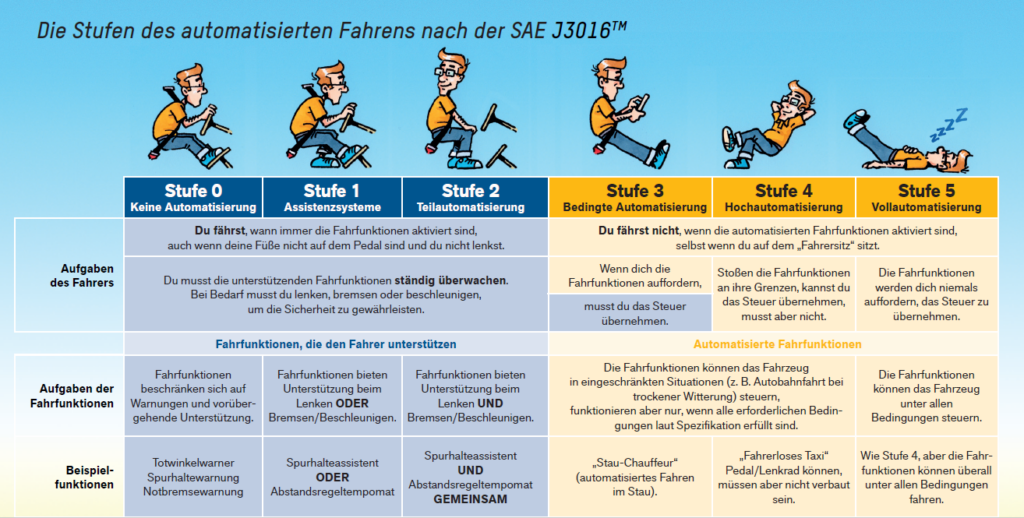Fully automated driving means cars can be on the road without a human driver. But before that happens, there are several intermediate levels. In these levels, technical assistants (“driver assistance systems”) gradually control steering, acceleration, and braking. The International Association of Automotive Engineers (SAE) has divided automated driving into five levels in SAE J3016. These levels are milestones on the road to full automation. They show how more and more automated features are being integrated.
If you would like to experience the individual stages of automated driving by yourself and get to know the most important differences, you are welcome to do so in our DEL.
No Driving Automation – “Level 0”

The vehicle is completely controlled by a human driver. The driver drives himself and must keep a constant eye on the traffic situation. Support systems (e.g. blind spot warning, lane departure warning, speed limit indicator, emergency brake warning) may be installed in the vehicle.
Level 1 – Driver Assistance

Advanced Driver Assistance Systems (ADAS) support the driver in certain situations by either controlling the accelerator and brakes (longitudinal guidance) or maintaining the lane (lateral guidance). For example, Lane Departure Warning keeps the car in its lane; Cruise Control maintains a constant speed; or Adaptive Cruise Control regulates a safe distance to the vehicle in front. However, the driver must remain alert and in control of the vehicle at all times.
Most newer cars have these features.
Level 2 – Partial Driving Automation

A Level 2 vehicle can stay in its lane while braking and accelerating. This is achieved by coupling several ADAS, such as adaptive cruise control (longitudinal guidance) together with lane departure warning (lateral guidance). Drivers can take their hands off the wheel briefly when the car is in partial-automated mode. However, the driver must always keep an eye on the traffic and the ADAS, correct any malfunctions and remain fully responsible at all times. The use of smartphones is not permitted at this level.
Well-known examples are Tesla’s autopilot and BMW’s highway assistant.
Level 3 – Conditional Driving Automation

The vehicle drives automatically in specific traffic scenarios, such as in traffic jams or on the freeway, and the driver can turn away from the traffic situation and the vehicle guidance. Because the legislation is not yet clear, it is currently not 100 % certain whether working, reading the newspaper, or using a smartphone will be permitted at this level. The driver must always be ready to take over the wheel within a certain time window if the system requests the driver to do so by using a specific signal. This request can be made if the vehicle has reached its technical limits, for example by leaving the current traffic scenario, if a construction site is not marked clearly, or if there is a technical defect.
Well-known examples are the Mercedes Drive Pilot and BMW Personal Pilot L3.
Level 4 – High Driving Automation

At Level 4, the driver no longer needs to concentrate on the traffic.
In certain situations, for example in dry weather on the motorway, the driving functions can take over full control of the car, provided all the necessary specifications are met. Otherwise the car is in a lower level of automation.
If the driver assistance system reaches its limits and the driver does not respond to the request to intervene, the car brings itself into a safe state, for example by driving onto the hard shoulder and stopping.
As soon as the vehicle leaves the Level 4-capable area (e.g. when exiting the motorway), it reverts to a lower level. The driver must then take control.
There are currently no Level 4-approved vehicles in the world.
Level 5 – Full Driving Automation

The vehicle completely takes over the driving tasks and steers itself under all conditions. Everyone inside the car becomes a passenger and can sit back and enjoy the journey. This offers the opportunity to extend the use of the vehicle to all people, regardless of age and driving ability. Children, adults, the elderly, and people with disabilities will no longer need a driver’s license to be mobile.
There are currently no Level 5-approved vehicles in the world.
